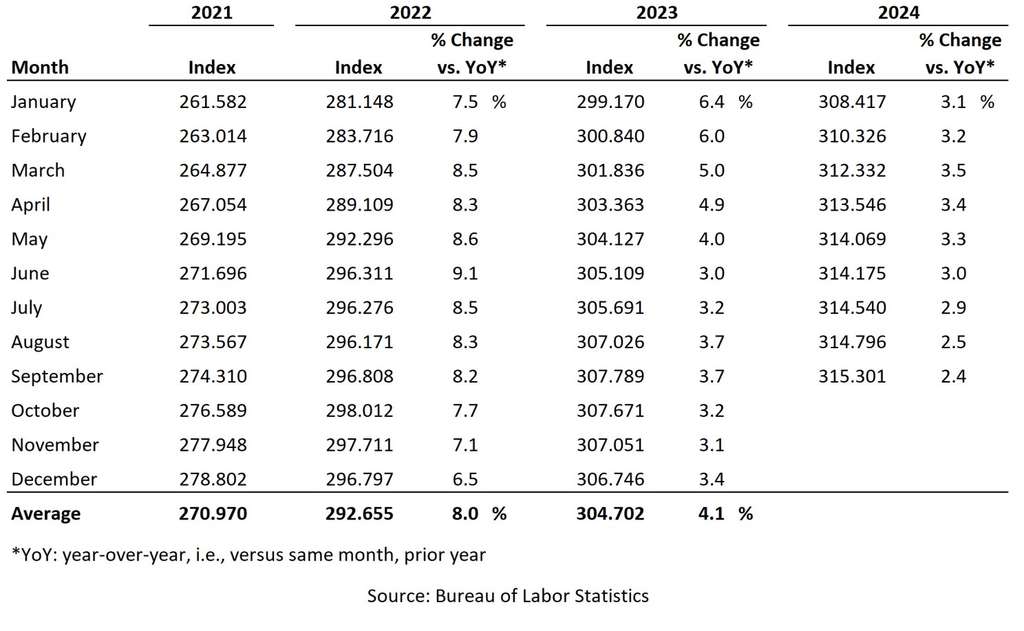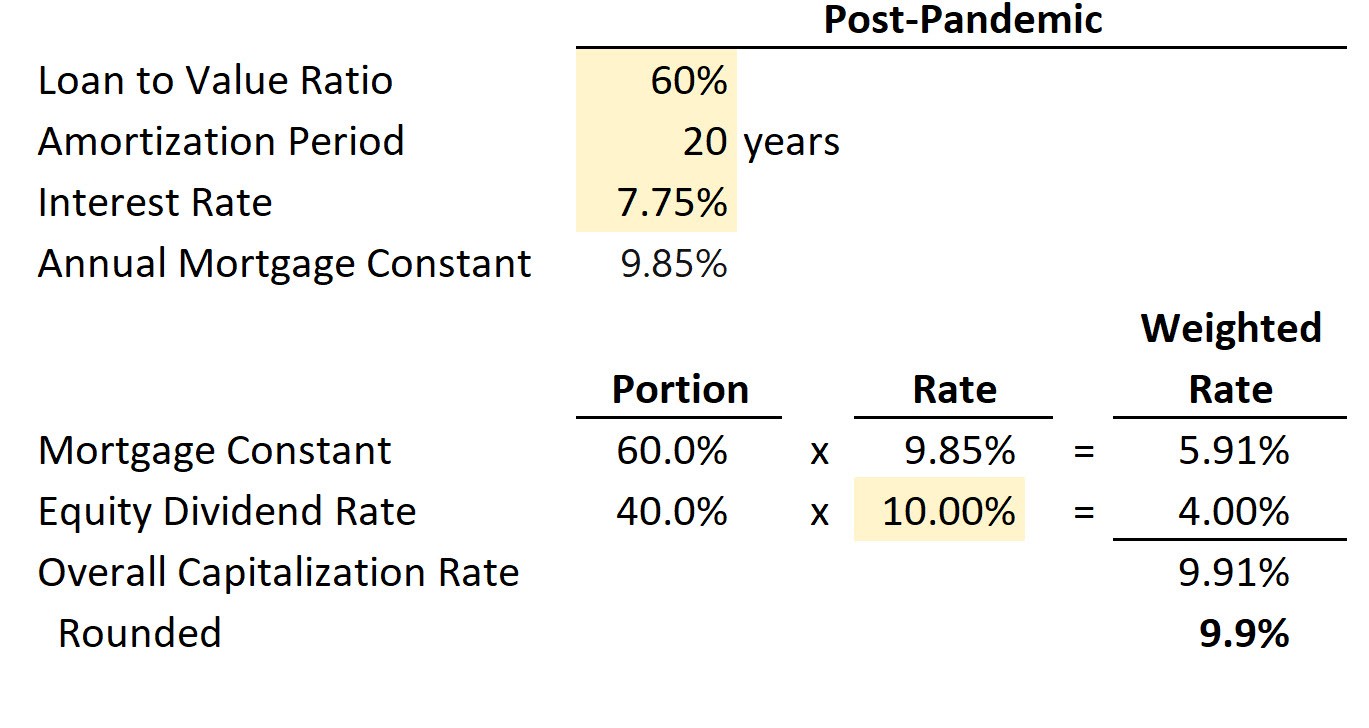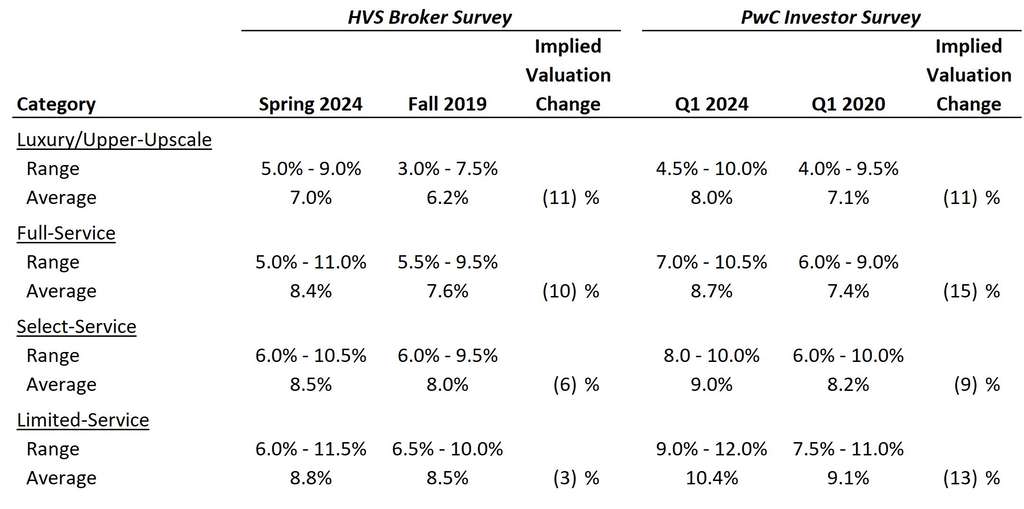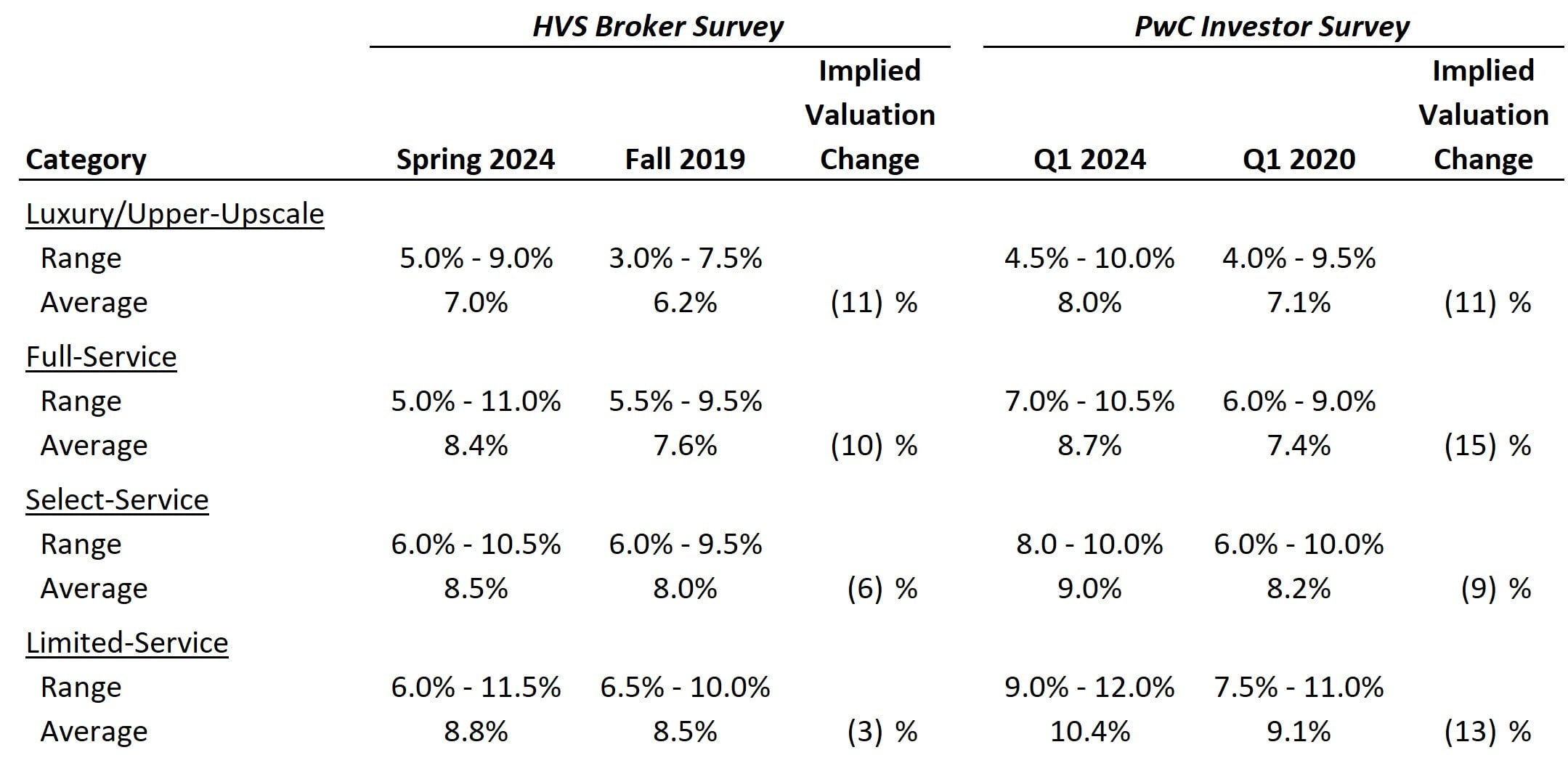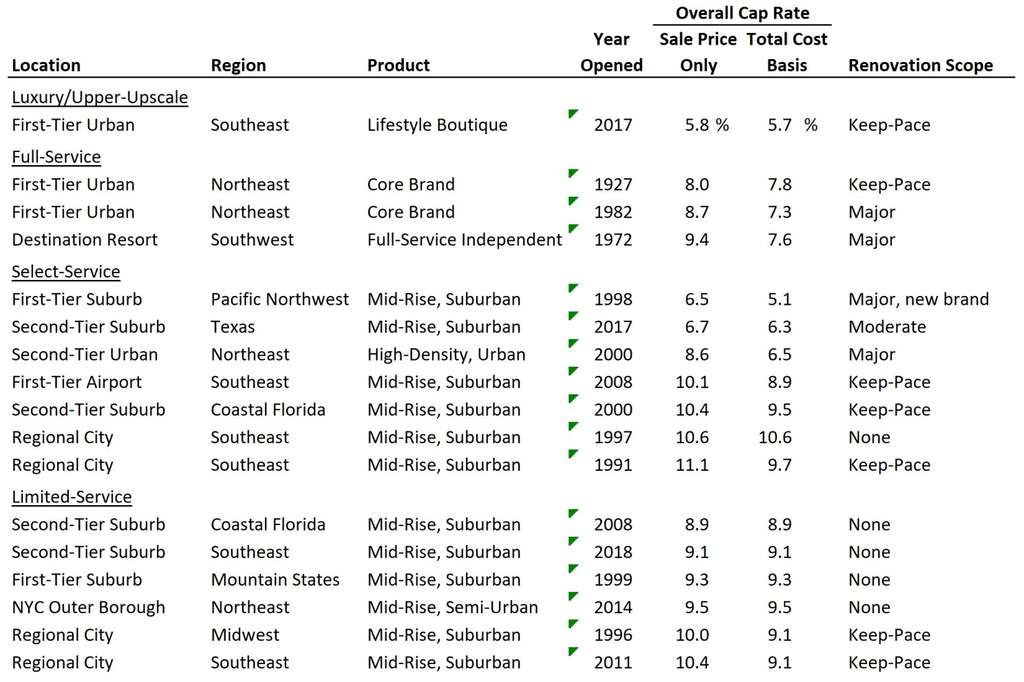Talking Hotel Cap Rates
This month, I am using an article authored by Erich Baum, Senior Vice President at HVS. Working at HVS for over 30 years, Erich has performed appraisal and consulting assignments in 47 of the 50 states, as well as Mexico and the Caribbean. Because of his range of experience, Erich focuses on the most complex jobs, including litigation-related assignments and atypical consulting work. In short, Erich is one of the brightest hotel consultants and appraisers I know, and this article demonstrates his superior knowledge and expertise.
A capitalization rate (“cap rate”) is a shorthand expression of a given investment’s return and represents the weighted average return to the debt and equity positions. As will be developed in this article, hotel cap rates are higher than they’ve been in recent years.
Component Parts
A cap rate can be constructed using the “band-of-investment” technique, requiring assumptions as to a) debt financing terms and b) the equity investor’s return requirement, measured by the dividend (cash on cash) rate. The following table identifies the technique using typical pre-pandemic inputs for hotels before the onset of the pandemic.
BAND-OF-INVESTMENT TECHNIQUE PRE-PANDEMIC
The annual mortgage constant is based on the interest rate and amortization period. The equity dividend rate is difficult to source; it’s not tracked in investor surveys or transaction data. However, logic dictates that the annual equity return should be materially higher than the debt return due to the higher risk factor.
Loan-to-value ratios for hotels have generally ranged from 50% to 80% over time. Because the debt component tends to account for most of the capital stack, debt costs tend to be the leading indicator for cap rate metrics.
Debt Cost Trends
Current hotel debt costs are well above the levels observed through the prior decade and even into the first two years of the pandemic. Debt costs began to increase in mid-2022 due to the inflation-reduction strategy implemented by the Federal Open Market Committee (“the Fed”) through its changes to the federal funds rate. The following table identifies the average annual federal funds rate over the past decade.
AVERAGE ANNUAL FEDERAL FUNDS RATE
The preceding data illustrates the magnitude of the shift in debt costs: the average federal funds rate in the first quarter of 2024 was more than 300 basis points higher than the pre-pandemic peak and over 500 basis points higher than the mid-pandemic low. Along with increasing interest rates, the Fed’s action has had the corollary effect of narrowing both amortization periods and loan-to-value ratios, placing further upward pressure on cap rates. The Fed’s most recent increase in the federal funds rate occurred in July 2023, by which time inflation had slowed significantly, as shown in the following table.
CPI-U Trends
After slowing to the current low of 2.4% in September 2024 (versus September 2023), the improvement allowed the committee to start rate reductions with a 50-basis-point reduction occurring in September. Current conventional wisdom predicts an additional 25 to 50 basis-point reduction through the balance of 2024. Even though overall inflation nears the target level, hotel mortgage interest rates are likely to remain above pre-pandemic norms. Thus, hotel cap rates are also likely to stay above pre-pandemic norms.
The following table revisits the band-of-investment technique using debt parameters that are more typical of the post-pandemic reality.
BAND-OF-INVESTMENT TECHNIQUE POST-PANDEMIC
With the increase in the mortgage constant and the decrease in the loan-to-value ratio, the calculated cap rate is 170 basis points higher than the pre-pandemic calculation. All things held equal, this cap rate increase implies a value reduction of 17%.
The cap rate increase and value reduction factors are more severe than those indicated by surveys and market-derived data. Equity investors have lowered their return thresholds in the near term, anticipating an eventual payoff once interest rates decline and the asset is refinanced.
Investor/Broker Surveys
The following table summarizes the results from two surveys of leading hotel investors and brokers with respect to overall, or going-in, cap rates (as opposed to terminal, or going-out, cap rates, an input used in discounted cash flow analyses). The table compares each survey’s current readings with the most recent pre-pandemic readings. The percentage difference in the two readings represents the implied valuation change.
INVESTOR SURVEYS- OVERALL CAP RATES
As noted above, the survey data suggests value loss factors of 3% to 15%, assuming static inflation-adjusted net income. The data suggests that higher quality assets have been prone to the most significant loss factors. Where inflation is concerned, the national CPI-U grew by 19% between 2019 and 2023. Thus, if a given hotel’s net income grew by 19% over this period, its value loss factor resulting from the cap rate increase would theoretically align with the factors noted above. To the extent net income growth exceeded or lagged this inflation factor, the value loss factor would be proportionately reduced or increased.
Surveys can be limited by a lack of market activity during slow cycles, where few transactions make it to the finish line. Limited market activity means limited data for survey participants to reference. The decline in commercial real estate investment activity resulting from the interest rate increases is well documented. In the hotel sector, sales activity dropped off significantly beginning in mid-2022. The decline coincides with what are otherwise relatively healthy times in the industry. Hotels have emerged as a less risky sector as compared to other forms of commercial real estate, particularly office buildings. Nevertheless, higher debt costs have inhibited market activity, with sellers resistant to realizing the value loss implied by higher cap rates.
Market-Derived Cap Rates
Investor surveys are prone to criticism because they are unempirical. They are not necessarily based on actual transactions, per se, and can also be interpreted as representations of desired or target return rates. But cap rates can also be market-derived, i.e., calculated based on actual sales data. Market-derived cap rates are almost always calculated using historical net income as the numerator, ideally from the most recent 12-month period preceding the sale date. As for the denominator, the sales price alone is almost always the selected input, without any upward adjustment for planned renovation expenditures. Inflexibility in these matters can result in illogical cap rates in the following cases.
· In cases where the transacted property has underperformed historically, and the winning bidder was obliged to base their offer on a significant income gain, the calculated cap rate will often skew downward. A more correct numerator in such a case is the stabilized net income forecast, deflated to Base Year or Year One dollars. Unfortunately, most buyer income forecasts are treated as proprietary and confidential, making such an adjustment impossible. And the time required to build up to stabilization represents an additional investment cost that is not accounted for with a simple deflation factor, thereby overstating the cap rate.
· Conversely, cap rates can be skewed upward when a keep-pace renovation is required, i.e., a renovation necessary for the property to maintain its current market position. In this scenario, the most correct inputs are historical net income in the numerator and the total cost basis (sales price plus renovation cost) in the denominator. Renovation cost estimates are commonly reported, but the upward adjustment to the denominator remains an atypical practice.
Another common situation involves assets slated for a major renovation that is expected to result in significant income growth. This situation presents an interesting dilemma. An argument can be made that using the historical net income in the numerator and the sales price in the denominator is a valid approach, considering both variables are understated relative to the buyer’s perspective: a) the net income is understated relative to the buyer’s income forecast, and b) the sales price is only a portion of the buyer’s total cost basis, which is factually the sales price plus the renovation cost. In this case, the calculated cap rate can still be a valid representation of the buyer’s underwriting, but only if the renovation-created income increment (most likely confidential) relates to the renovation cost at the same rate as historical income over sales price. Ideally, the numerator would be adjusted upward to reflect the buyer’s stabilized income (deflated), and the denominator would be adjusted upward to reflect both the sales price and the renovation cost. The complexity of these matters highlights the challenges associated with relying on market-derived cap rates.
With these limitations in mind, the following table identifies a small sample of cap rates derived from actual hotel sales. In most cases, HVS appraised the transferred hotel as part of the transaction, and the sale involved a single asset only (i.e., no portfolio sales). In all cases, we have calculated the cap rates based on the most recent 12-month historical income results in the numerator. For the denominator, we have used two premises: a) sales price only and b) sales price plus renovation cost, i.e., “total cost basis.”
MARKET-DERIVED CAP RATES: OCT 2023 - APRIL 2024
The extent to which the calculated cap rate data for any given sale is valid depends in large part on the buyer’s income forecast, which, again, is typically not disclosed. When a buyer assumes significant income growth as part of their underwriting, the cap rates are often significantly understated. And, the magnitude of the understatement only grows when the sales price is adjusted to include the renovation costs. This understatement is most likely in cases where a major renovation was planned for completion following the acquisition. In those scenarios, the first cap rate calculation, using the sale price only, is likely the more valid representation of the buyer’s underwriting premise.
Conversely, in cases where a keep-pace renovation was planned, cap rates calculated based on the sales price alone are likely to be overstated. As noted above, six of the transfers indicated cap rates of 10.0% or higher. For five of these sales, a keep-pace renovation was planned. If the renovation cost is factored into the denominator to create a true total cost basis, the cap rate for each transfer falls to the 9.0% to 10.0% range, which represents the more correct representation of buyer perspectives.
Considered broadly, limitations notwithstanding, the indicated results roughly align with the survey findings presented earlier, which is logical considering that most survey participants are directly or indirectly involved with establishing investment parameters for underwriting and valuation purposes. This is perhaps the best argument for survey data reliance.
Conclusion
Note that compared to other forms of real estate, hotels are idiosyncratic, and the number of variables impacting the acquisition decision are difficult to objectively account for. The simplicity of the “Value = Net Income ÷ Cap Rate” equation belies the complexity of the underwriting process that typically grounds a hotel buyer’s investment decision. Significant factors can include branding/management issues, opaque buyer/seller motivations, and atypical lease encumbrances, to name just a few. In addition, many transactions are part of large portfolio sales, where sales data is only reported in the aggregate. Nevertheless, the metric is useful because of its simplicity, for giving hotel market participants a tool for communicating with brevity a summary view of an acquisition’s economics, as well as communicating changes in the return thresholds required by hotel debt and equity markets over time.
As for where we are now, a new reality is dawning. The post-pandemic increases in hotel debt costs have pushed cap rates up, which translates into value loss, all other things held equal. As the sluggish investment market shows, the process of reckoning with the new cap rate reality remains a work in progress. However, there is a light at the end of the tunnel. As the Fed continues to reduce rates, mortgage costs will further decline, and cap rates will trend lower. Whether they will decline to pre-pandemic levels remains to be seen.
Rushmore on Hotel Valuations, please subscribe on LinkedIn or send an email to [email protected]




